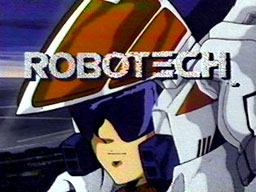
Robotech is an American science fiction franchise that began with an 85-episode anime television series produced by Harmony Gold USA in association with Tatsunoko Production; it was first released in the United States in 1985.

USS Voyager(NCC-74656) is the fictional Intrepid-class starship which is the primary setting of the science fiction television series Star Trek: Voyager. It is commanded by Captain Kathryn Janeway. Voyager was designed by Star Trek: Voyager production designer Richard D. James and illustrator Rick Sternbach. Most of the ship's on-screen appearances are computer-generated imagery (CGI), although models were also sometimes used. The ship's motto, as engraved on its dedication plaque, is a quote from the poem "Locksley Hall" by Alfred, Lord Tennyson: "For I dipt in to the future, far as human eye could see; Saw the vision of the world, and all the wonder that would be."
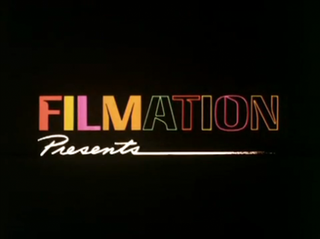
Filmation Associates was an American production company that produced animation and live-action programming for television from 1963 until 1989. Located in Reseda, California, the animation studio was founded in 1962. Filmation's founders and principal producers were Lou Scheimer, Hal Sutherland and Norm Prescott.
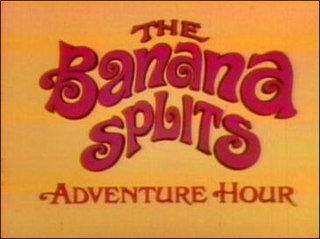
The Banana Splits is an American television variety show produced by Hanna-Barbera Productions and featuring the Banana Splits, a fictional rock band composed of four costumed animal characters in red helmets with yellow crests. The costumed hosts are Fleegle, Bingo, Drooper, and Snorky.
M.A.S.K. is a 1985 animated television series produced by DIC and ICC TV Productions, Ltd. The series was based on the M.A.S.K. action figures produced by Kenner Products. It was animated in Japan by Ashi Productions, Studio World and K.K. DiC Asia.
Voyagers! is an American science-fiction television series about time travel that aired on NBC from October 3, 1982, to July 10, 1983, during the 1982–1983 season. The series starred Jon-Erik Hexum and Meeno Peluce.

Seaview, a fictional nuclear submarine, was the setting for the 1961 motion picture Voyage to the Bottom of the Sea, starring Walter Pidgeon, and later for the 1964–1968 ABC television series of the same title. In the film, Seaview fires a ballistic missile with a nuclear warhead to extinguish the Van Allen belt that was set on fire by a space cataclysm.
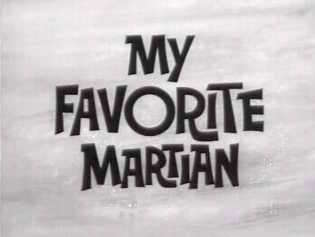
My Favorite Martian is an American sitcom that aired on CBS from September 29, 1963, to May 1, 1966, for 107 episodes. The show stars Ray Walston as "Uncle Martin" and Bill Bixby as Tim O'Hara. The first two seasons, totaling 75 episodes, were in black and white, and the 32 episodes of the third and final season were filmed in color.

Fantastic Voyage is a 1966 American science fiction adventure film directed by Richard Fleischer and written by Harry Kleiner, based on a story by Otto Klement and Jerome Bixby. The film is about a submarine crew who is shrunk to microscopic size and venture into the body of an injured scientist to repair damage to his brain. In adapting the story for his script, Kleiner abandoned all but the concept of miniaturization and added a Cold War element. The film starred Stephen Boyd, Raquel Welch, Edmond O'Brien, Donald Pleasence, and Arthur Kennedy.
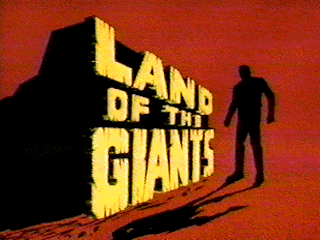
Land of the Giants is a one-hour American science fiction television series that aired on ABC for two seasons, beginning on September 22, 1968, and ending on March 22, 1970. The show was created and produced by Irwin Allen. Land of the Giants was Allen's fourth science-fiction TV series. The show was released by 20th Century Fox Television. The series was filmed entirely in color and ran for 51 episodes. The show starred Gary Conway and special guest star Kurt Kasznar.

Marvin Elliott Miller was an American actor. Possessing a deep baritone voice, he began his career in radio in St. Louis, Missouri before becoming a Hollywood actor. He is remembered for voicing Robby the Robot in the science fiction film Forbidden Planet (1956), a role he reprised in the lesser-known The Invisible Boy (1957).

This Is America, Charlie Brown is an eight-part animated television miniseries that depicts a series of events in American history featuring characters from the Charles M. Schulz comic strip Peanuts. It aired from 1988 to 1989 on CBS. The first four episodes aired as a weekly series in October and November 1988; the final four episodes aired monthly from February to May 1989.
"The 37's" is the first episode of the second season, and seventeenth episode overall, of the American science fiction television series Star Trek: Voyager. Due to differing release schedules, it was also released as the final episode of the first season in other countries. The episode aired August 28, 1995, on UPN. Directed by James L. Conway, it was written by producers Jeri Taylor and Brannon Braga. It was originally intended to be a two-part episode to bridge between the first and second seasons, and was subsequently re-written to be a single part. Due to late changes to the final act of the episode, special effects shots of the settlers' cities could not be completed, with which Braga and series creator Michael Piller were unhappy.

Fantastic Four, also known as Fantastic Four: The Animated Series, is the third animated television series based on Marvel's comic book series of the same name. Airing began on September 24, 1994, until ending on February 24, 1996. The series ran for two seasons, with 13 episodes per season, making 26 episodes in total.

Voyage to the Bottom of the Sea is a 1964–1968 American science fiction television series based on the 1961 film of the same name. Both were created by Irwin Allen, which enabled the film's sets, costumes, props, special effects models, and sometimes footage, to be used in the production of the television series. Voyage to the Bottom of the Sea was the first of Irwin Allen's four science fiction television series, and the longest-running. The show's theme was underwater adventure.
"Macrocosm" is the 54th episode of Star Trek: Voyager, the 12th episode of the third season. The title borrows the philosophical term macrocosm, definable as a larger world that mirrors what exists in a miniature world, or microcosm.

The Aurora Plastics Corporation was an American toy and hobby manufacturing company. It is known primarily for its production of plastic scale models of cars, airplanes, and TV and movie figures in the 1960s. Its principal competition in modeling were various other plastic modeling firms like Revell and Monogram.

Star Blazers is an American animated television series adaptation of the Japanese anime series Space Battleship Yamato I (1974), II (1978), and III (1980). Star Blazers was first broadcast in the United States in 1979. It was the first popular English-translated anime that had an overarching plot and storyline that required the episodes to be viewed in order, which paved the way for future arc-based, plot-driven anime translations. It also dealt with somewhat more mature themes than other productions aimed at the same target audience at the time.
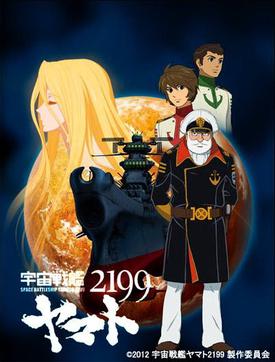
Star Blazers 2199, known in Japan as Space Battleship Yamato 2199, is a 2012–2013 Japanese military science fiction anime television series that is a remake of the first Space Battleship Yamato television series created by Yoshinobu Nishizaki and Leiji Matsumoto in 1974, known in the United States as Star Blazers. The series is a space opera, and was originally screened back-to-back in theaters across Japan, a few episodes at a time prior to release on home video, and aired on television from April 7, 2013, to September 29, 2013. Voyager Entertainment currently licensed the series outside Japan, with Funimation streaming their English dub of the series starting on November 8, 2017.















